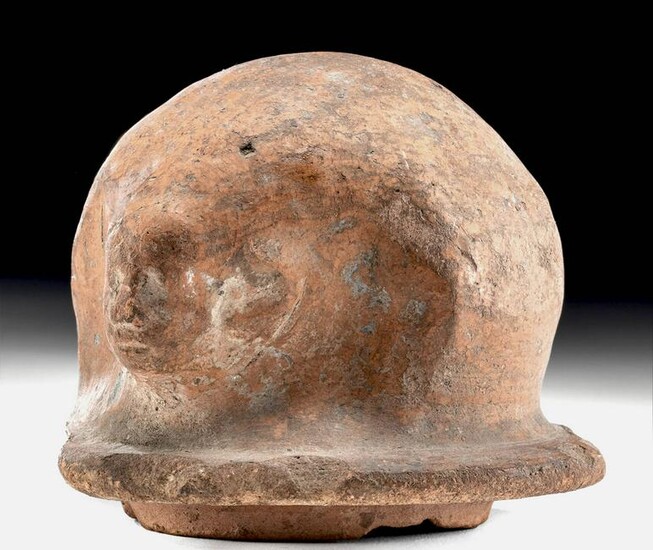Egyptian Terracotta Canopic Lid - Imsety / Son of Horus
Ancient Egypt, Third Intermediate to Late Dynastic Period, 21st to 31st Dynasty, ca. 1070 to 332 BCE. A hand-built pottery lid for a canopic jar containing the face of Imsety, the human-headed son of the four Sons of Horus. The hollow lid has a squat base ring surmounted by a broad periphery, and Imsety's stylized visage protrudes out from between the lappets of his wig. Canopic jars were made to hold and protect specific internal organs for the deceased through their journey to the afterlife as well as throughout eternity itself. Size: 4.125" W x 3.3" H (10.5 cm x 8.4 cm)
Canopic jars are some of the most iconic artifacts from Egypt, made to hold internal organs removed during the mummification process. This tradition lasted for an incredibly long time - the first evidence for a canopic chest containing organs comes from the Fourth Dynasty (ca. 2600 BCE) and they were used into the late 1st millennium BCE. The 18th Dynasty marked a shift in canopic jar tradition, when these jars were given to all people of status, and when their heads were fashioned to look like the four Sons of Horus, including Imsety. The Four Sons were charged with protecting the internal organs, as they had originally been charged with protecting the body of Osiris. Imsety protected the liver and had a special relationship with the goddess Isis.
Provenance: private J.H. collection, Beaverton, Oregon, USA; ex-Sands of Time Ancient Art, Washington, D.C., USA
All items legal to buy/sell under U.S. Statute covering cultural patrimony Code 2600, CHAPTER 14, and are guaranteed to be as described or your money back.
A Certificate of Authenticity will accompany all winning bids.
PLEASE NOTE: Due to recent increases of shipments being seized by Australian & German customs (even for items with pre-UNESCO provenance), we will no longer ship most antiquities and ancient Chinese art to Australia & Germany. For categories of items that are acceptable to ship to Australia or Germany, please contact us directly or work with your local customs brokerage firm.
Display stands not described as included/custom in the item description are for photography purposes only and will not be included with the item upon shipping.
#149725
Condition Report: Losses to two areas of rim beneath head as shown. Abrasions and nicks to top, face, rim, and bottom, with softening to facial details, light encrustations, and a few stable hairline fissures within interior. Nice earthen deposits throughout and smooth surface textures along topside.
View it on
Estimate
Time, Location
Auction House
Ancient Egypt, Third Intermediate to Late Dynastic Period, 21st to 31st Dynasty, ca. 1070 to 332 BCE. A hand-built pottery lid for a canopic jar containing the face of Imsety, the human-headed son of the four Sons of Horus. The hollow lid has a squat base ring surmounted by a broad periphery, and Imsety's stylized visage protrudes out from between the lappets of his wig. Canopic jars were made to hold and protect specific internal organs for the deceased through their journey to the afterlife as well as throughout eternity itself. Size: 4.125" W x 3.3" H (10.5 cm x 8.4 cm)
Canopic jars are some of the most iconic artifacts from Egypt, made to hold internal organs removed during the mummification process. This tradition lasted for an incredibly long time - the first evidence for a canopic chest containing organs comes from the Fourth Dynasty (ca. 2600 BCE) and they were used into the late 1st millennium BCE. The 18th Dynasty marked a shift in canopic jar tradition, when these jars were given to all people of status, and when their heads were fashioned to look like the four Sons of Horus, including Imsety. The Four Sons were charged with protecting the internal organs, as they had originally been charged with protecting the body of Osiris. Imsety protected the liver and had a special relationship with the goddess Isis.
Provenance: private J.H. collection, Beaverton, Oregon, USA; ex-Sands of Time Ancient Art, Washington, D.C., USA
All items legal to buy/sell under U.S. Statute covering cultural patrimony Code 2600, CHAPTER 14, and are guaranteed to be as described or your money back.
A Certificate of Authenticity will accompany all winning bids.
PLEASE NOTE: Due to recent increases of shipments being seized by Australian & German customs (even for items with pre-UNESCO provenance), we will no longer ship most antiquities and ancient Chinese art to Australia & Germany. For categories of items that are acceptable to ship to Australia or Germany, please contact us directly or work with your local customs brokerage firm.
Display stands not described as included/custom in the item description are for photography purposes only and will not be included with the item upon shipping.
#149725
Condition Report: Losses to two areas of rim beneath head as shown. Abrasions and nicks to top, face, rim, and bottom, with softening to facial details, light encrustations, and a few stable hairline fissures within interior. Nice earthen deposits throughout and smooth surface textures along topside.



